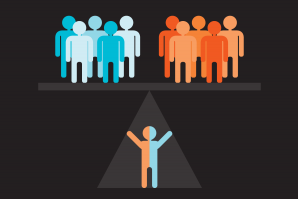In an age of relentless digital distraction, Fair Oaks resident Frank Possemato offers a refreshingly analog antidote. Possemato’s self-published workbook, “How to Live an Analog Life in a Digital World,” delivers sage advice with a simple message.
Possemato drives this message home in the book’s final chapter, where he writes, “Digital life isn’t going away, but analog life survives in your soul if you make room for it.”
It was during the onset of the COVID-19 pandemic, with its sudden shift to remote teaching, that Frank Possemato, a 48-year-old English teacher at Cosumnes River College and Sierra College, found himself overwhelmed by his digitally immersed life. A poet and short fiction author with publications in several independent journals, Possemato turned to writing as a way of gaining control over his changing life. A year and a half later, what emerged is a quick, 51-page life hack manual on surviving digital overwhelm.
While not a memoir, Possemato doesn’t stray from sharing his own life experiences and frustrations with readers. Each short chapter reads like a personal narrative, with a direct, conversational tone that shifts between past and present tense as Possemato shares observations and advice on breaking the addiction to technology. Each chapter also includes one or more practical exercises designed to encourage readers to experience life outside of the digital world.
Encouraging readers to seek out connection via (phone-free) face-to-face conversations, Possemato reminisces on the meandering, hours-long conversations he shared with a childhood friend named Jay. “Those conversations were like a fire; once they were burning, they had their own momentum. New topics were like firewood, and we had plenty. It was warm. It was inviting. It was consuming and self-perpetuating,” he writes.
Those early conversations among friends, he points out, were vastly different from ones shared today, which are subject to constant interruption by our cell phones and their relentless demands for attention. Possemato’s philosophical insights here are simple yet bring to light truths that are often overlooked in the throes of busy lives.
Pulling inspiration from Chinese philosopher Lao Tzu, he highlights today’s constant barrage of options and the very real experience of decision fatigue with a quote: “Those with less become content. Those with more become confused.” Possemato’s solution? Ask yourself at any given time, “What am I doing?” This introspective activity is one of many that the author prescribes to help readers get more in touch with their analog life.
For those grappling with the modern work-life balance, Possemato’s chapter on productivity offers a vital perspective. He highlights the paradox of digital tools: they promise efficiency yet often deliver distraction. Possemato’s solution is not to abandon technology, but to strategically disconnect. He argues that intentional breaks focused self-reflection and a clear understanding of one’s priorities are essential for reclaiming control and achieving true productivity. His emphasis on knowing oneself, including strengths and weaknesses, elevates this section beyond typical time-management tips, giving readers powerful advice for navigating not just work, but life, in the digital age.
Possemato writes, “The analog life — the one where you have time to yourself, not shared with a device, where you keep the fire of face-to-face, voice-to-voice contact alive in your daily life, where you make time to feel and know what’s happening around and inside you — can help you know yourself.”
The book offers suggestions to achieve this through activities like rearranging to-do lists to reflect what actually matters to you (not just your boss) and a simple, yet often difficult, challenge to drive without using distracting devices. Beyond productivity, Possemato provides a range of suggestions for improving quality of life, including engaging the senses, learning to trust your memory and even fostering stronger romantic connections.
From the humble beginnings of scribbled notes in inexpensive composition notebooks, Frank Possemato’s “How to Live an Analog Life” is a refreshingly authentic manifesto that reads like a letter from an old friend. Possemato’s approach to marketing — largely through word of mouth — is true to the book’s analog theme. While initially launched as an Amazon e-book in January 2025, the book will be available in analog form through a direct-to-print service later this spring.
–
Recommended For You

Business Book Review: ‘Going Remote: How the Flexible Work Economy Can Improve Our Lives and Our Cities’
As a residual effect of the COVID-19 pandemic, the world experienced an unprecedented shift in workforce practices. As office doors closed and the digital realm beckoned, millions of American workers embarked on an unexpected journey into remote work.

Book Review: ‘Artists Remaking Medicine’
Health care professionals and artists learn from each other in a new anthology
Just released in September of 2023, this anthology on the intersection of art and medicine offers a poignant look at the history, practice and future of radical creativity in the industry.

Book Review: ‘Housing for Humans’
An architect advocates for creative, simple solutions to the affordable housing crisis
Washington, D.C., based architect Ileana Schinder is a relentless advocate for residential and urban design solutions that can offer pathways for addressing today’s pernicious affordable housing crisis. She highlights these in her book “Housing for Humans: A Book to Imagine, Create and Design a New Housing Model in America.”

Book Review: ‘The Art of Badassery: Unleash Your Mojo With Wisdom of the Dojo’
A martial artist and health coach helps women apply dojo discipline to personal life and business
Whether the opponent is an overbearing boss, financial hardship or a testy love relationship, Jennifer Cassetta shows readers how to create a roadmap for ascending beyond one’s fears, turning challenges and setbacks into superpowers.

Book Review: The Nature of the Tribe
Tribal Leadership: Leveraging Natural Groups to Build a Thriving Organization
We live in a world of tribes. On a macro level, we discover that every organization is a tribe, a cadre of people involved in formal and informal levels of engagement. The existence of these tribes has major implications for today’s leaders in their quest to create world-class teams, businesses and companies that make a difference.

Book Review: Hard-Hitting Consulting How-To
‘Million Dollar Consulting: The Professional's Guide To Growing A Practice’ is not for the faint of heart
So-called expert consultants abound, but Alan Weiss’ Million Dollar Consulting: A Professional Guide To Building A Practice offers what many other how-tos don’t: modern, actionable tools for building a highly profitable enterprise.



